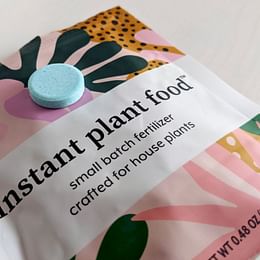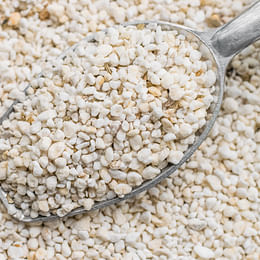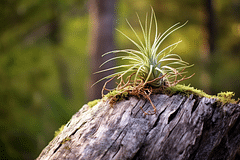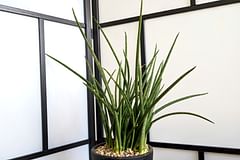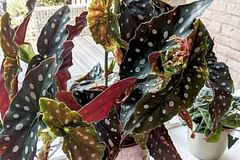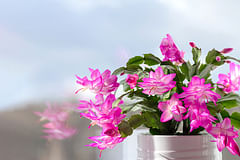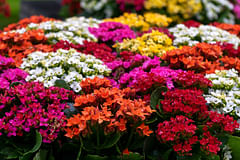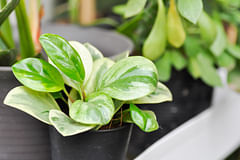How to care for the Schefflera (Umbrella Tree)
Learn tips and tricks on how to properly water, fertilize, repot, and prune the Schefflera (Umbrella Tree). Discover common pests that might affect your plant and find out if it’s toxic for cats and dogs. With a few simple steps, you can successfully take care of an Umbrella Tree.

Are you looking for a tree you can grow indoors? The Schefflera, also known as the Umbrella Tree, might be the perfect plant for you! This low-maintenance indoor tree can add a touch of nature to any room in your house, as long as you've got a nice, bright spot for it! With the right plant care tips and guidance, anyone, including beginners, can enjoy taking care of this plant in their home.
As an expert with years of experience caring for houseplants, I'm here to help you learn how to properly take care of your Schefflera so it will thrive and bring joy into your life!
In this plant care guide, we're going to look at these aspects of taking care of a Schefflera:
- How often should you water the Schefflera (Umbrella Tree)?
- What are the signs of overwatering for the Schefflera (Umbrella Tree)?
- What are the signs of underwatering for the Schefflera (Umbrella Tree)?
- When should you water Schefflera?
- What are the sunlight requirements for the Schefflera (Umbrella Tree)?
- What are the signs of too much sunlight for the Schefflera (Umbrella Tree)?
- What are the signs of too little sunlight for the Schefflera (Umbrella Tree)?
- What is the ideal temperature range for the Schefflera (Umbrella Tree)?
- How much humidity does the Schefflera (Umbrella Tree) need?
- What is the best soil for my Schefflera (Umbrella Tree)?
- How often should I prune my Schefflera (Umbrella Tree)?
- Help Schefflera to grow taller and bushier
- How do I propagate my Schefflera (Umbrella Tree)?
- How often should I repot my Schefflera (Umbrella Tree)?
- How often should you fertilize the Schefflera (Umbrella Tree)?
- Plant care routine for Schefflera in different seasons
- What should I do if my Schefflera becomes too big?
- What are signs that my Schefflera is stressed?
- Common pests for Schefflera
- Is the Schefflera toxic for cats and dogs?
Let's get started on learning how to properly take care of your Schefflera so it can bring a touch of nature and joy into your home!
How often should you water the Schefflera (Umbrella Tree)?
One of the most important parts of keeping your plant healthy for a long time is watering it correctly. When it comes to watering your Schefflera, less is more! During the warmer months, you should water your tree about once a week, allowing the top of the soil to dry out before you water it again. When temperatures are cooler, you can reduce watering to about every other week, or even less.
The Schefflera thrives in lightly moist soil but doesn't mind standing in dry soil for a week or so. On the other end, you should be careful not to overwater your Schefflera, as it's quite sensitive to this. Too much moisture can cause root rot on your plant.
You should always water your plant with room temperature water and water it thoroughly. The goal is to moisten the entire root system without saturating the soil. A great way to water your plant like this is by using a pot with a drainage hole and watering the plant until moisture starts to drip out of the drainage hole.
Another great way to water your Schefflera is by bottom-watering your plant. You can do this by placing the plant in a bucket and adding one to 2 inches of water to the bucket. The plant and soil will slowly soak up moisture. Let your plant absorb the moisture for 10-15 minutes and then let any excess moisture drain from the bottom of the pot. This will help you regulate how much moisture your Schefflera is absorbing and puts your plant less at risk of getting overwatered.
What are the signs of overwatering for the Schefflera (Umbrella Tree)?
When it comes to houseplants, overwatering is often the biggest cause of problems and can sometimes be hard to detect. When it comes to your Schefflera, there are a few signs that you should look for that could indicate overwatering.
One of the first signs of overwatering is yellow or drooping leaves that feel weak and limp to the touch. Another sign of overwatering is wilting caused by root rot. If your Schefflera has been in consistently wet soil for too long, you might notice that the lower leaves are wilting and turning yellow. The last sign of overwatering is fungal growth in your plant. If you see any white or brown spots on your Schefflera, it could be a sign of fungal growth caused by too much moisture in the soil.
If you notice any of these signs, it's a good indication that your plant is getting too much water. If this is the case, you should drain the excess moisture quickly and let the soil dry out.
What are the signs of underwatering for the Schefflera (Umbrella Tree)?
Underwatering is another common houseplant problem. Your Schefflera doesn't mind drying out for a week or so, but if it's dry for too long, you'll start to see some signs of underwatering.
One of the first signs that you might notice is drooping leaves or a wilting plant. Leaves that become dry and crispy to the touch are another sign of underwatering. If your Schefflera has been severely underwatered, you might also notice discoloration on the leaves, usually in the form of yellowing.
If you do notice these signs, it's important to give your Schefflera a good soaking right away. If the plant hasn't been drying out for too long, it'll bounce right back.
When should you water Schefflera?
So, too much and too little water isn't good, but how do you know when to water your Schefflera? One effective method is to feel the soil moisture about two inches down.
If it feels dry and crumbly, you'll need to water your plants. However, if it feels consistently wet or soggy, it's a sign you should wait longer before watering your plant.
By checking the soil, you don't have to wait until your plant starts to show signs of trouble.
Another good technique is to watch for changes in the leaves. Healthy leaves should be vibrant and firm, so if you notice droopiness or curling, it's time to check if your plant needs some water.
What are the sunlight requirements for the Schefflera (Umbrella Tree)?
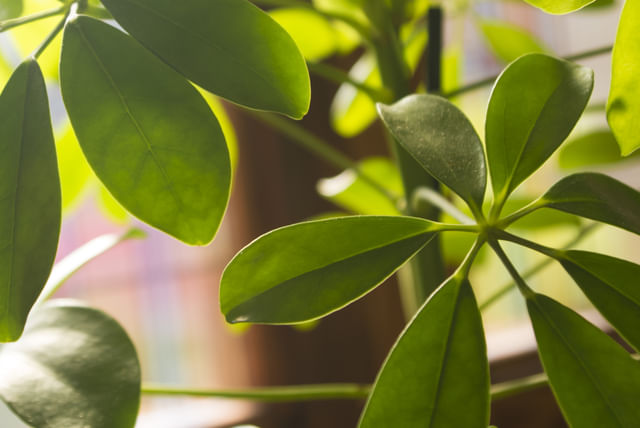
The Schefflera (Umbrella Tree) enjoys bright, indirect sunlight. You should keep this indoor tree away from direct sunlight, especially during the spring and summer, as it will cause the leaves to scorch or dry out too quickly.
The best spot for the Schefflera is a bright spot where it gets filtered light. This protects the leaves from sunburns and makes sure that the plant gets enough light for even and bushy growth. If you don't have a bright spot available, you can also give your Schefflera a slightly darker spot. It'll be fine in this type of sunlight exposure, but it will grow less quickly and will also tend to grow towards the light.
To prevent your plant from growing to one side, it's a good idea to rotate your indoor tree once per week. By rotating your plant, each side gets exposed to the sunlight evenly and this helps the plant to grow straight up, rather than to one side.
What are the signs of too much sunlight for the Schefflera (Umbrella Tree)?
The Schefflera can easily get sunburned if it is exposed to too much direct sunlight in the afternoon. You can recognize signs of too much sunlight on your plant by looking for yellow or discolored leaves, brown or black spots on the leaves, and crispy edges on the leaves.
If you notice any of these signs, it's important to move your Schefflera to a spot with bright, indirect sunlight as soon as possible.
What are the signs of too little sunlight for the Schefflera (Umbrella Tree)?
The signs of too little sunlight for the Schefflera (Umbrella Tree) can be hard to detect, as the symptoms will develop very gradually. Signs of not enough sunlight can include pale-green leaves that are smaller than normal, long and spindly stems (leggy stems), and slow or stunted growth.
What is the ideal temperature range for the Schefflera (Umbrella Tree)?
The ideal temperature range for a Schefflera is between 15 - 21 degrees Celsius (59 - 70 F). Most houses are already in this temperature range, so you probably won't have to take any special steps to make this plant happy.
Just make sure that you're not placing your houseplant in direct sunlight, as this direct sunlight will warm up the plant and the space around the plant too much in the spring and summer.
Another thing to keep in mind is that you should protect your Schefflera from extreme temperature changes, so it's best to keep it away from air conditioners or drafty windows. If your Schefflera gets exposed to temperatures below 15 degrees Celsius (59 F), it will start to drop leaves.
How much humidity does the Schefflera (Umbrella Tree) need?
The Schefflera (Umbrella Tree) prefers medium to high humidity levels in your house. Ideally, the Schefflera grows in a spot that gets between 50-60% humidity levels. Most houses will already have these humidity levels in the spring and summer but might need a little extra humidity during the fall and winter.
During the colder months, you use a lot more central heating, so the air in your house becomes much dryer.
You can increase the humidity around your houseplant by misting its leaves with a spray bottle once or twice a week, and you can also use a humidifier to increase the levels even further. You can find more ways to increase humidity here: 10 ways to raise the humidity in your house
What is the best soil for my Schefflera (Umbrella Tree)?
Many plants have many different requirements when it comes to soil, but the Schefflera is quite an easy-going plant that does well in most types of general potting soil. However, there are a few things you should be aware of when choosing the right potting soil.
Make sure that the soil is well-draining and not too compact, as this will help to prevent root rot. To help improve the drainage of your soil, you can mix in perlite or pumice. These ingredients will drain any excess moisture to the bottom of the pot quickly, so your plant is never growing in soil that stays moist for too long.
To help your plant stay healthy for a long time, you should consider using a pot with a drainage hole. This drainage hole will prevent your plant from standing in a puddle of water in the pot. This puddle of water could cause root rot quite easily, so a drainage hole helps you keep your plant healthy.
How often should I prune my Schefflera (Umbrella Tree)?
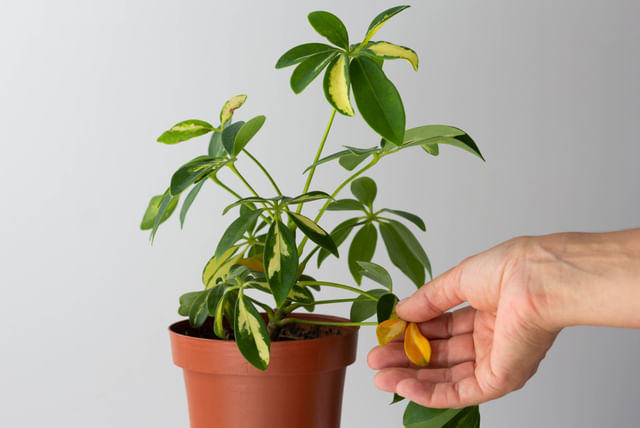
You should prune your Schefflera (Umbrella Tree) as needed to keep it healthy and looking its best. Generally, you should be pruning away any dead or damaged leaves and stems as they appear. This will help promote good air circulation around the plant, encourage new growth, and keep the houseplant from becoming overcrowded.
Another great reason to prune your Schefflera is to keep it at a certain size. These plants do grow quite quickly and you might not have space for a large tree. Pruning will help you to control the size of the plant, so it stays perfect for your living spaces.
How do I prune my Schefflera (Umbrella Tree)?
When pruning your Schefflera (Umbrella Tree), you should use a pair of sharp scissors or shears to cut away any dead or damaged leaves, stems, and branches. You should also remove any crossed branches, as they can cause the houseplant to become overcrowded and weaken its overall structure. Make sure to clean your scissors or shears before and after you prune to reduce the chance of spreading any diseases from plant to plant.
When it comes to pruning houseplants, it's important to remember that less is more. Pruning too much can damage your houseplant, so don't be afraid to take it slow and only remove what needs to be removed. With a little patience and practice, you'll soon be pruning like a pro!
Help Schefflera to grow taller and bushier
If you're looking to help your Schefflera grow taller and bushier, there are 3 things you can do that really make a big difference.
One of the best ways to promote bushier growth is to regularly prune your plant. Trim back the top stems of your Schefflera, especially if it's beginning to stretch and grow taller without branching out. By cutting just above a leaf node, you'll tell the plant to produce new side shoots, creating a fuller appearance.
If you also start to rotate the plant every few weeks, you make sure that all sides get equal sunlight. This helps to keep all sides of the tree looking full.
Looking for bonus points on helping your Schefflera to grow larger? Make sure to regularly fertilize your tree, especially if you've had it for at least a year. The soil won't have a lot of nutrients after the first year, so by fertilizing your plant, you help it to keep growing.
Last but not least, repotting is a great way to give your plant extra growing space if it has been growing well for 2-3 years. Repotting in a slightly larger pot when it outgrows its current pot is a great way for the roots to spread out and absorb more of the nutrients in the soil.
How do I propagate my Schefflera (Umbrella Tree)?
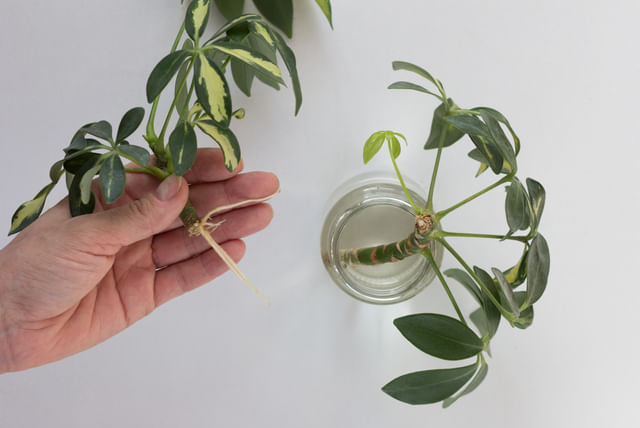
Propagating your Schefflera is a great way to multiply this houseplant without having to buy additional plants. The best time to propagate your Schefflera is during the spring and summer when your plant is actively growing.
The best way to propagate your houseplant is by taking stem cuttings. To do this, use a pair of sharp scissors or shears and take a cutting of around 4-5 inches. Make sure the cutting contains several leaves, and that you have cut the stem just below a node (the place where the leaf is attached to the stem).
Once you have taken your cutting, place it in a small pot with lightly moist soil and now it's time to wait. Depending on the time of year, you can expect roots to start growing within 4-6 weeks. If your plant successfully grows roots, you can keep it in the small pot until the next spring. This is when you can repot it in a slightly larger pot. By taking this process slowly, you avoid accidentally stressing your plant.
How often should I repot my Schefflera (Umbrella Tree)?
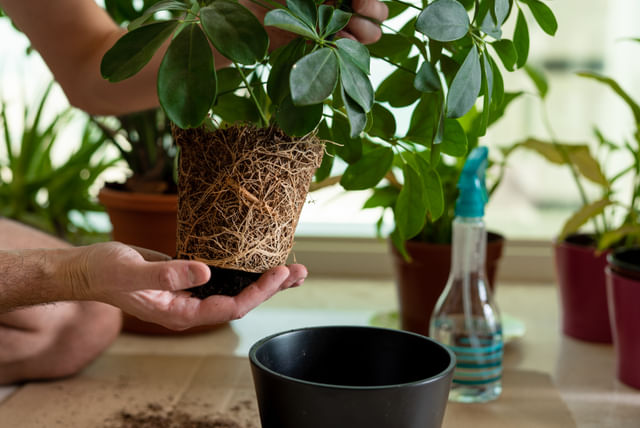
The Schefflera (Umbrella Tree) is a fast-growing houseplant but likes to grow in a pot that's quite small for the size of the plant. The Schefflera doesn't need to be repotted very often. On average, you should repot it every 2-3 years or when it outgrows its current pot.
When repotting, make sure to use a container with a drainage hole, and use well-draining potting soil. When it comes to choosing the right size pot for your plant, you should pick a pot that's one size larger than its current pot. Usually, this means that your pot should be around 2.5 cm (1 inch) larger on each side.
If you choose a pot that's much larger than the current pot, you risk overwatering your plant. The extra soil in a pot that's too large will stay moist for longer and could cause root rot.
How do I repot my Schefflera (Umbrella Tree)?
Repotting your Schefflera (Umbrella Tree) is a great way to ensure its growth continues smoothly and to refresh its soil. First, choose a new pot that’s about 1-2 inches larger in diameter than the current one, ensuring it has good drainage holes. Start by gently removing the plant from its existing pot. You can do this by tipping the pot sideways and gently squeezing the sides to loosen the root ball. It’s important to handle the plant carefully to avoid damaging the roots.
Next, inspect the roots for any signs of rot or disease and trim away any unhealthy sections. Fill the bottom of the new pot with fresh potting mix suitable for indoor plants. Place the Schefflera in the center of the pot and fill around the sides with more soil, firming it gently to remove air pockets. Water the plant thoroughly after repotting, allowing excess water to drain out. This will help settle the soil around the roots and promote healthy growth.
Keep an eye on your plant for the next few weeks as it adjusts to its new home!
How often should you fertilize the Schefflera (Umbrella Tree)?
Fertilizing your Schefflera (Umbrella Tree) is key to promoting its lush growth and overall health. The Schefflera is a fast-growing plant that should be fertilized once per month during the spring and summer. During the winter months when the plant is dormant, you shouldn't fertilize the plant, as this can lead to overfertilizing and cause permanent damage to your indoor tree.
Using a balanced fertilizer specifically formulated for houseplants will provide the necessary nutrients without overwhelming your Schefflera. It's best to follow the instructions on the fertilizer package regarding application to prevent over-fertilization, which can harm the plant.
Remember, observing your Schefflera's response to fertilization—such as its growth rate and leaf color—will help you adjust your routine as needed to ensure it stays happy and healthy!
What type of fertilizer is best for my Schefflera (Umbrella Tree)?
You can use a liquid fertilizer or slow-release pellets, but whichever one you choose, make sure that it's specifically made for houseplants. This will make sure that your houseplant receives all the nutrients it needs without you having to worry about overfeeding or burning it with too much fertilizer.
If you have a choice of fertilizer to use, I recommend you use a liquid fertilizer. This type of fertilizer is easy to use and easy to control, and your plant can absorb the nutrients quickly. Mix the fertilizer with water and follow the instructions of the manufacturer on the label of the fertilizer.
Plant care routine for Schefflera in different seasons
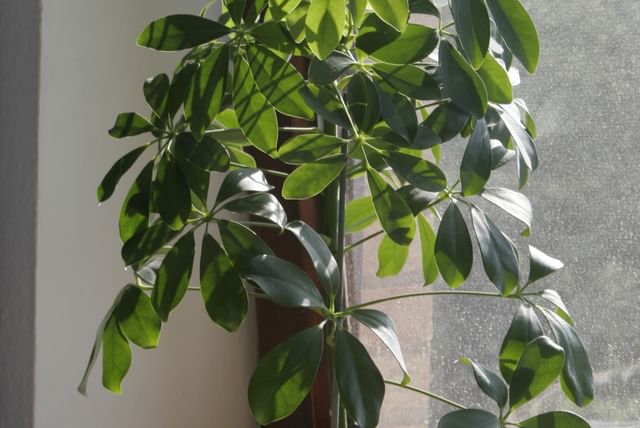
As with most other plants, each season brings different care requirements for your Schefflera. It's important to understand why your plant's care requirements change and what you can do to keep your plant healthy during the whole year. Below, we'll look at seasonal care tips you can start using right now.
Spring
As the days grow longer and temperatures rise, your Schefflera will enter its active growing phase. Increase watering to keep the soil consistently moist but not soggy, and start feeding it with a balanced fertilizer once a month to support new growth. Ensure that it's getting bright, indirect light to help energize its growth. This is also a great time to inspect for any pests and prune for shape, encouraging a bushier appearance.
Summer
During the summer months, your Schefflera will be thriving in warmer temperatures and plenty of light. Continue with your regular watering routine, checking the soil moisture frequently, as it may dry out faster in the heat.
Fertilize every month to maintain its energy levels, and consider moving it outdoors for the season if the temperatures outside are within the ideal temperature range and it is protected from direct sunlight. Just be sure to gradually acclimate it to any new lighting conditions to avoid shock.
If you keep your Umbrella Tree indoors, make sure it stays away from air conditioning units or drafts to avoid sudden temperature changes.
Fall
As temperatures start to drop and daylight hours shorten in the fall, your Schefflera will begin to slow down its growth. Reduce watering slightly, allowing the top inch of soil to dry out between waterings, and stop fertilizing as it goes into dormancy. Move the plant to a brighter location if possible, as this will help it adapt to the reduced natural light. Keep an eye out for any signs of stress, as indoor heating can affect humidity levels.
Winter
In winter, your Schefflera won't really grow. Continue to let the soil dry out a bit more than usual before watering, as the plant won't need a lot of moisture. Avoid fertilizing during this time, as the plant is not actively growing and doesn't need any nutrients.
Maintain stable indoor temperatures away from drafts and direct heat sources to prevent large temperature changes throughout the day. If the natural light of winter isn't enough for your Umbrella Tree, you can start using grow lights to help give your Schefflera, and other plants, a bit of extra sunlight.
What should I do if my Schefflera becomes too big?
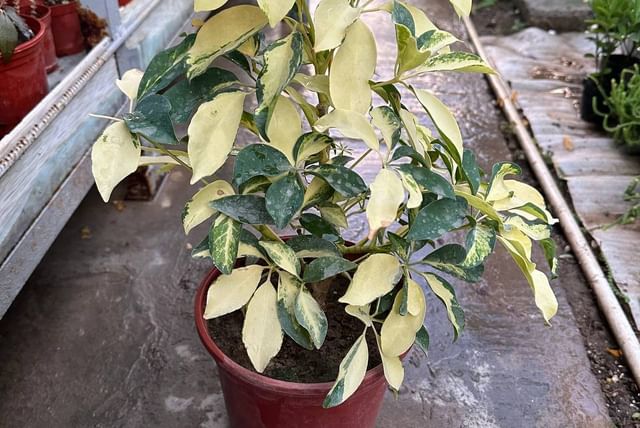
If your Schefflera has outgrown its space, there are several steps you can take to control its size.
If you're fine with it growing larger, you can repot your plant into a larger container. Choose a pot that is about 2-5 cm (1-2 inches) wider in diameter than the current one, and make sure it has drainage holes.
When repotting, gently remove the plant from its current pot, inspect the roots, and trim any that are unhealthy. Fill the new pot with fresh, well-draining potting soil, place the Schefflera in the center, and lightly pack the soil around the roots. Water thoroughly after repotting to help establish the plant in its new home.
Keeping your Schefflera smaller
If your Schefflera has become too big and you want to stop it from growing any larger, there are there are 3 things you can do.
The first thing to do is to prune your Schefflera. Trim back the stems to make it less tall and also make it look bushier at the same time. Be sure to cut just above a leaf node so that new growth can start to grow from there.
If you simply don't have space for a larger plant, think about propagating it. You can take cuttings from the top of the plant and propagate them in water or soil, allowing you to maintain a smaller, more manageable plant while still enjoying the beauty of a Schefflera.
And the third option is to regularly trim the roots. Normally, when the plant outgrows its pot, you need to repot it in a larger pot. But you can also trim the roots back by about 1/3 and keep growing it in the same pot. Schefflera will regrow the trimmed roots, and you'll have to repeat this once every 1-2 years, but you won't need a bigger pot.
What are signs that my Schefflera is stressed?
Stress is your plant's biggest enemy, because a stressed plant is an easy target for pests and diseases. Just like any other living thing, your plant will clearly show you signs when it's stressed. So by regularly checking up on your plant, you can catch these symptoms early and help your plant recover.
Here are the most common signs of stress for Schefflera.
Drooping leaves
One of the most noticeable signs of stress in your Schefflera are drooping leaves. When the leaves start to sag or lose their perky appearance, it can mean that it's either overwatered or underwatered. If the soil is overly soggy, the roots may be struggling to get the oxygen they need, leading to wilting. But if the soil is too dry, the plant won't have the moisture to properly function.
Yellowing leaves
Yellowing leaves are another clear indicator that your Schefflera is experiencing some type of stress. This can happen for a few reasons, like overwatering, nutritional deficiencies, or too little sunlight.
If leaves start to turn yellow from the bottom up, it often means that the plant is struggling with soil that's too wet and it can't absorb enough nutrients because of it.
Leaf drop
If you notice your Schefflera is start to drop its leaves, it's a sign that it's very stressed. Leaf drop can be triggered by sudden environmental changes, like extreme changes in temperature, humidity, or light levels. It can also happen when your plant has been overwatered or underwatered for too long.
If you've recently moved your plant and it's starting to drop its leaves, don't do anything. Your plant needs time to adjust to its new growing environment. By moving it again, you only make the stress worse.
Pests or disease
As we learned earlier, a stressed plant is a great target for pests and diseases. These pest infestations or diseases will only make this stress worse, and that can attract even more pests and diseases.
You can recognize pests and diseases by sticky residue, webbing, or brown spots on the leaves. Common pests like spider mites, aphids, or scale insects can weaken the plant and cause it to become stressed.
Make it a habit to check your plant every few weeks for any signs of pests or unusual spots, and treat any infestations as soon as you can with insecticidal soap or neem oil. To help your plant fight these problems, you can also improve air circulation and give your plant the right humidity levels.
Common pests for Schefflera
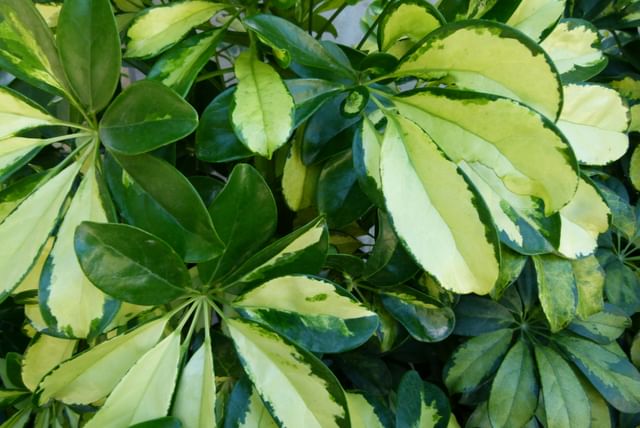
In the previous section we've learned that pests are attracted to a stressed plant and Schefflera is no expection, unfortunately.
The Schefflera is prone to several types of pests, including spider mites and scale insects. These pests can cause damage to the houseplant by sucking out its sap and leaving behind a sticky residue or spots on the leaves.
If you've noticed a pest getting to your Schefflera, there are a few things you can do to get rid of this pest. One of the best ways is to regularly wipe down the leaves with a damp cloth or sponge to help remove any potential invaders and keep them from settling in.
One thing these pests hate is humidity, so if you're struggling to get rid of a pest, make sure to raise the humidity around your plant. You can also find eco-friendly ways to get rid of and prevent pests from invading your Umbrella Tree here
How should I clean the leaves of my Schefflera (Umbrella Tree)?
Cleaning the leaves of your Schefflera (Umbrella Tree) is an easy way to keep pests away and to help your plant shine. Dust likes to collect on your plant's leaves over time, which makes it quite difficult for them to photosynthesize efficiently, so cleaning them is really important.
To clean the leaves, start by gently wiping them down with a soft, damp cloth or sponge. It's best to use lukewarm water to avoid shocking the plant. Be careful not to apply too much pressure, as the leaves can be sensitive and may bruise easily. For stubborn dirt or residue, you can mix a few drops of mild dish soap with water to create a gentle cleaning solution.
Dip your cloth or sponge into the soapy water, wring it out, and wipe the leaves again, followed by a rinse with plain water to remove any soap residue. You can also place your Schefflera outside during a soft rain (if it's warm enough) to give it a natural rinse and boost its humidity levels.
Is the Schefflera toxic for cats and dogs?
Unfortunately, the Schefflera is toxic to your pets, including cats and dogs. The sap in the plant can cause vomiting, kidney and heart problems, difficulty with swallowing, a burning sensation in or around the mouth, and drooling.
Because of these serious issues, I highly recommend you keep this plant away from any curious pets and small children. If you notice that your pet or small children have gotten in contact with the sap of the Schefflera, make sure to contact your GP or veterinarian right away.
Is the Schefflera (Umbrella Tree) toxic to humans?
Schefflera is also considered toxic to humans, but only if eaten. While the plant is not highly toxic, it contains compounds that can cause mild symptoms such as nausea, vomiting, or irritation. Because of this, make sure to keep your Schefflera away from small children and pets who might be curious and tempted to taste the leaves.
Thank you for reading this post! I hope it helps you to keep your plants healthy and beautiful! If you're looking for more guides on specific plants, you can always request a plant guide to get a guide for the plant you have trouble with.
Test your plant care knowledge
Quiz completed!
Want to learn more? Sign up for my newsletter to receive free tips in your inbox!
Sign up now!